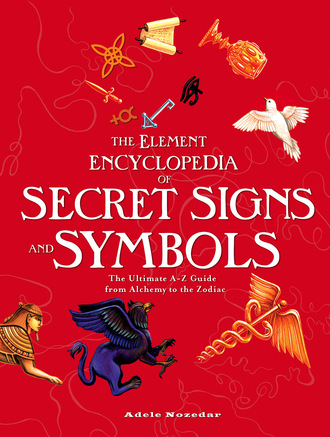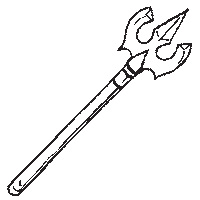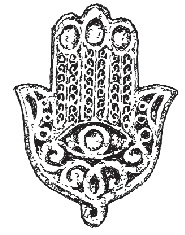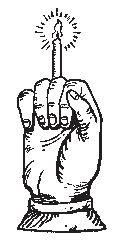
Полная версия
The Element Encyclopedia of Secret Signs and Symbols
It is also worth bearing in mind the philosophical meanings of the word “level,” meaning steady and honest, as well as its practical application as a tool. These two meanings are inextricably linked from the actual symbol of the tool itself.
8. RULE
Correct measurements, defined by the rule, are essential to the physical construction of a building, and ensure that the design concept will work in the real world. Also of significance are the degrees of measurement that are depicted on the actual ruler itself; in the imperial measurements, these degrees of 12 and 24 correspond to the daily cycle of the Sun. In this sense, the rule represents the macrocosm. The rule also keeps everything in order, and acts as a guide.
9. TRIANGLE
To Freemasons, the triangle symbolizes the Greek capital D, which they call the “shining Delta.” The triangle also indicates the meanings of things in triplicate, such as “right thinking, right speaking, and right doing.” On a microcosmic scale, the base of the triangle represents duration, and the two sides symbolize the qualities of light and darkness, male and female, etc. Possibly the most famous symbolic use of the Masonic triangle—which traditionally has an angle of 36 degrees at the apex and two angles of 72 degrees at the base—is the one that includes a blazing star and also a pentagram as seen on the Seal of the United States and on the United States dollar.
10. TRACING BOARD OR TRESTLE BOARD
As with many of the symbols inherent within Freemasonry, the tracing board itself is a symbolic representation of an important piece of practical equipment used in masonry.
The tracing, or trestle, board has its origins in the flat piece of wood or cloth that was used as a drawing board by the Master Mason, on which he sketched the dia-grams, schemes, and measurements needed for the building work in question. Initially represented as a piece of cloth which was rolled out on the floor at the beginning of a Masonic meeting, the tracing board is now a piece of wood that contains the signs and symbols relevant to the Brothers within their degrees of Masonic hierarchy. The boards are elaborate works of art, with the symbols woven into the whole in a pictorial, allegorical way. The symbols that are already mentioned in this section all take their place. The seemingly simple builders’ tools serve to remind the initiate of their more esoteric spiritual meanings that amount to the betterment of the person and personal enlightenment.
There are hundreds, if not thousands, of different sorts of tracing boards, all usually the work of individual artists. Different tracing boards show the different degrees of the Craft.
As well as showing pictures of the tools involved with practical masonry, tracing boards might tell the story of Hiram Abiff’s murder or perhaps show pictures of the ritual re-enactment of this crime as part of initiation ceremonies. Tracing boards also represent features of the actual temple: the pillars, the checkerboard floor, the porch with its two columns.
11. MASONIC APRON
The humble apron of the working Mason is elevated to almost religious status by the Freemasons. Generally made of leather, the way the apron is worn symbolizes the status of its wearer, with the bib worn up for the apprentice, or down by superior grades. Wearing the apron is representative of work and the necessity to be busy and industrious, and also of the fig leaves worn by Adam and Eve; as such the apron preserves the modesty of the wearer. Like the tracing board, the Masonic apron has the signs and symbols of the Craft embroidered on it.
One of the most famous of the many Masonic aprons is that which belonged to George Washington. Given to him in 1784 by the Marquis de Lafeyette whose wife embroidered the apron, it displays many Masonic symbols. Nothing is left to chance; the border colors of red, white, and blue are not only the national colors of France but also of the USA. Other symbols on this historic apron include:
the All Seeing Eye—
watchfulness, the Supreme Being;
rays—show the power of the Supreme Being to reach inside the hearts of men;
rainbow—symbolic of the arch of Solomon’s Temple that is supported by the two pillars, Jachim and Boaz;
Moon—the female principle;
globes on top of pillars—peace and plenty;
the three tapers—symbolize the three stages of the Sun; rising in the East, in the Southern sky at noon, and setting in the West;
trowel—symbolic of spreading love and affection, the “cement” that binds the Brothers of Freemasonry;
five-pointed star—represents friendship;
checkered pavement—often a feature of temples and again is based on the floor of Solomon’s original temple and represents the duality of opposites, male and female, and so on;
steps—represent the degrees of masonry;
coffin—represents death and therefore rebirth and is a recurrent motif in Freemasonry;
skull and crossbones—symbols of mortality but also of rebirth;
acacia;
compasses;
the square and level;
the ark—safety and refuge;
tassel and knot—the ties that bind the Brothers;
the Sun—the Light of God, the male principle;
sword and heart—symbolic of justice being done; nothing can be hidden from the eyes of the Great Architect;
seven six-pointed stars—here, seven stands for the seven liberal arts and sciences;
beehive—a symbol of industry and a reminder that man should be rational and industrious at the same time.
12. 47th PROBLEM OF EUCLID, ALSO KNOWN AS THE BRIDE’S CHAIR
This mathematical theorem has been called one of the foundations of Freemasonry. It is called the 47th Problem for no more esoteric reason than Euclid published a book of theorems, of which this was number 47.
Its significance within Freemasonry is somewhat nebulous. However, the beginnings of the Fellowship in architecture and construction, and the usefulness of the 47th Problem as a measuring device, might give us the answer. The design features in Masonic regalia including lodge decorations and Masonic “jewels.”
The 47th Problem is also called the Egyptian string trick, and a practical demonstration in making of the shape illustrates its efficacy perfectly. Take a piece of string and tie 12 knots at exact intervals along the string. Then join the ends of the string, again making sure that the knots are evenly spaced. Hammer a stick into the ground. Put one of the knots over the stick. Stretch three divisions of knots and sink another stick into the ground at the point of the third knot. Then take a third stick and skewer it into the ground at the point where a fourth knot falls. This gives a triangle in the proportions of three, four and five, and further, the lines of the string can be extrapolated to make three squares of 9 parts, 16 parts, and 25 parts.
This simple device enabled the Egyptians to remeasure their fields after the Nile flooded every few years, washing away the boundary markers. The Egyptian string trick results in a perfect right angle, an essential device in the construction of a building, and as essential today as it was thousands of years ago, although methods of constructing the angle may have changed. Pythagoras traveled to Egypt and may have discovered it there, or he may have discovered it alone. Whatever the case, it is this geometrical solution that caused him to shout “Eureka.” In addition, it is said that 100 bulls were sacrificed in honor of the importance of this seemingly simple discovery, indubitably one of the secrets that was part of the hidden knowledge of the Master Mason; it may well have been one of the pieces of information for which Hiram Abiff was murdered.
13. ASHLAR
In material terms, ashlar is the rough stone that comes straight from the quarry. In philosophical terms, to the Freemason, ashlar symbolizes the rough and imperfect state of man before he is rendered smooth and perfect in his ideally realized state. It relates to the alchemical idea of base matter that can be perfected through intellectual and spiritual realization.
14. POINT WITHIN THE CIRCLE
A seemingly simple symbol, the circle with a dot at its very center is a sign of birth and resurrection dating back to Egyptian times when it was used as an emblem of the Sun God, Ra. The symbol is associated particularly with the days of St. John the Baptist and St. John the Evangelist, which fall on the summer and winter solstices respectively.
15. THE TEMPLE FLOOR
Although it is stated time and time again that the symbols inherent within Freemasonry are nondogmatic and are as such open to interpretation, it is safe to say that the features of the actual temple form an important part of the secret signs of the Craft. The floor of the temple is no exception.
It is constructed of checkered tiles of black and white. These colors represent the duality of opposites; night and day, dark and light, male and female, fire and water, Earth and air, and all the other manifestations of this concept. In
Ancient Egypt, the colors were used as a reminder of the need to unify spirit and matter.
16. GAOTU
Abbreviated words, initials, and acronyms form a large part of Masonic ritual, since the pronunciation of certain words is believed to dilute their power and abbreviations are used instead. The abbreviation of GAOTU stands for Great Architect of the Universe, which in turn refers to God. Here there is a parallel to the nature of God as the builder or designer of the macrocosm, and the role of the Freemason as the designer of the microcosm.
GUNGNIR

This is the magical weapon known as Odin’s Spear or Javelin. Like Mjolnir, the magical hammer belonging to Odin, Gungnir—whose name means “The Unwavering One”—has two very practical qualities that render it an essential tool in the arsenal of the powerful thunder god; it always hit its mark, and it always returns, like a boomerang, back to the thrower. As well as being a sacred object, there is a runic symbol, Gar, that also represents the Gungnir.
HALO
The halo, aureole, or aura all refer to an emanation of light, generally depicted appearing around the head. The halo is a symbol of spiritual sanctity or of divine grace, used in Christian iconography, for example, in pictures of saints. Although the halo is the sign that a person is blessed by the Divine, some people claim that they can actually see this phenomenon, and that the many colors of the aura that surrounds the entire body can be used as a diagnostic tool.
HAND OF FATIMA

Also known as the Khamsa, the Hand of Fatima is named for Fatima Zahra, the daughter of Mohammed. It is a very ancient symbol, often used as a talisman, and in the Middle East it is ubiquitous, appearing in houses, shops, in taxis, and hotels. The hand is not really shaped like a normal human hand, but has two balanced thumbs and no little finger. The eye in its palm wards off the evil eye, so the Hand of Fatima is a double symbol of protection since the palm, held up, is a forbidding gesture. Khamsa actually means “five” and has relevance for both Muslims and Jews. Peace activists have adopted the Hand of Fatima in recent years; a reminder that the two faiths have many commonly shared beliefs.
HAND OF GLORY

If magical charms have more efficacy the harder they are to construct or come by, then the Hand of Glory must be powerful indeed. Noticeably absent from New Age emporia, the Hand of Glory was popular with thieves during the sixteenth century. It was a light, or candle, made from the severed hand of a hanged convict. After this grisly relic was mummified by being embalmed in oils and special herbs, it was turned into a candle using tallow also made from a hanged corpse.
The Hand of Glory was the favored tool of thieves because, once alight, it was said to render household members unconscious. Therefore the thief could go about his nefarious activities undisturbed.
HEX SYMBOLS

In the south-eastern part of Pennsylvania lives a population of European settlers, primarily from the Rhine area. These people come from different religious communities including Lutheran, Moravian, Quakers, Mennonites, and others. Some of these groups, despite their deeply held religious beliefs, are united by one thing; a thriving belief in witchcraft, also known as Hexerie, from the German, Hexe, meaning “witch.”
Despite their godliness, these are a very superstitious people. One of the popularly held beliefs is that a cross, drawn on the door-latch, will prevent the Devil from entering the house.
Конец ознакомительного фрагмента.
Текст предоставлен ООО «ЛитРес».
Прочитайте эту книгу целиком, купив полную легальную версию на ЛитРес.
Безопасно оплатить книгу можно банковской картой Visa, MasterCard, Maestro, со счета мобильного телефона, с платежного терминала, в салоне МТС или Связной, через PayPal, WebMoney, Яндекс.Деньги, QIWI Кошелек, бонусными картами или другим удобным Вам способом.



